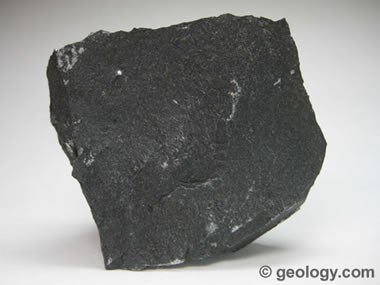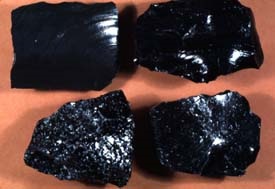As with any geocache you can claim / log / earn a "find" for this EarthCache if you complete the requirements listed at the bottom of the page.
To get to the Earthcache:
There is a parking lot at Black Sand Basin which is very near the trail and the listed cooordinates.
Two types of black rocks found in Yellowstone National Park include Basalt and Obsidian.
Both of these rock types are
Extrusive Igneous Rocks.
What are Igneous Rocks?
Igneous rocks are formed from the solidification of molten rock material.
There are two basic types:
1) Intrusive igneous rocks such as diorite, gabbro, granite and pegmatite that solidify below Earth's surface.
Intrusive, rocks come from magma. Intrusive, or plutonic, igneous rock forms when magma is trapped deep inside the Earth. Great globs of molten rock rise toward the surface. Some of the magma may feed volcanoes on the Earth's surface, but most remains trapped below, where it cools very slowly over many thousands or millions of years until it solidifies. Slow cooling means the individual mineral grains have a very long time to grow, so they grow to a relatively large size. Intrusive rocks have a coarse grained texture.
2) Extrusive igneous rocks such as andesite, basalt, obsidian, pumice, rhyolite and scoria that solidify on or above Earth's surface.
Extrusive, rocks come from lava. Extrusive, or volcanic, igneous rock is produced when magma exits and cools outside of, or very near the Earth's surface. These are the rocks that form at erupting volcanoes and oozing fissures. The magma, called lava when molten rock erupts on the surface, cools and solidifies almost instantly when it is exposed to the relatively cool temperature of the atmosphere.
Quick cooling means that mineral crystals don't have much time to grow, so these rocks have a very fine-grained or even glassy texture. Hot gas bubbles are often trapped in the quenched lava, forming a bubbly, vesicular texture. Pumice, obsidian, and basalt are all extrusive igneous rocks.

|
Basalt is a fine-grained, dark-colored extrusive igneous rock composed mainly of plagioclase and pyroxene.
|

|
Obsidian is a dark-colored volcanic glass that forms from the very rapid cooling of molten rock material. It cools so rapidly that crystals do not form. The specimen shown above is about two inches (five centimeters) across.
|
What is Basalt?
Basalt is a dark-colored, fine-grained, igneous rock composed mainly of plagioclase and pyroxene minerals. It most commonly forms as an extrusive rock, such as a lava flow, but can also form in small intrusive bodies, such as an igneous dike or a thin sill.
Basalt is usually grey to black in color, but rapidly weathers to brown or rust-red due to oxidation of its mafic (iron-rich) minerals into rust. Although usually characterized as "dark", basaltic rocks exhibit a wide range of shading due to regional geochemical processes; indeed some basalts are quite light coloured, in some cases superficially resembling rhyolite to untrained eyes. Basalt almost always has a fine-grained mineral texture due to the molten rock cooling too quickly for large mineral crystals to grow.
Earth's Most Abundant Bedrock
Basalt underlies more of Earth's surface than any other rock type. Most areas within Earth's ocean basins are underlain by basalt. Although basalt is much less common on continents, lava flows and flood basalts underlie several percent of Earth's land surface. Basalt is also an abundant rock on the Moon. Much of the Moon's surface is underlain by basaltic lava flows and flood basalts. Basalt commonly erupts on the third largest moon of Jupiter, and has also formed on Mars and Venus.
Basalt-Forming Environments
Most of the basalt found on Earth was produced in just three rock-forming environments: 1) oceanic divergent boundaries, 2) oceanic hotspots, and 3) mantle plumes and hotspots beneath continents.
1) Basalts at Oceanic Divergent Boundaries
Most of Earth's basalt is produced at divergent plate boundaries on the mid-ocean ridge system. Convection currents deliver hot rock from deep in the mantle. This hot rock melts as the divergent boundary pulls apart and erupts onto the sea floor.
2) Oceanic Hotspots
Significant amounts of basalt are produced is above oceanic hotspots. These are locations where a small plume of hot rock rises up through the mantle from a hotspot on Earth's core. The Hawaiian Islands are an example of where basaltic volcanoes have been built above an oceanic hotspot.
Basalt production at these locations begins with an eruption on the ocean floor. If the hotspot is sustained, repeated eruptions can build the volcanic cone larger and larger until it becomes high enough to become an island. All of the islands in the Hawaiian Island chain were built up from basalt eruptions on the sea floor.
3) Plumes & Hotspots Below Continents
The third basalt-forming environment is a continental environment where a mantle plume or hotspot delivers enormous amounts of basaltic lava through the continental crust and up to Earth's surface. These eruptions can be from either vents or fissures. They have produced the largest basalt flows on the continents. The eruptions can occur repeatedly over millions of years producing layer after layer of basalt stacked in a vertical sequence.
Uses of Basalt
Basalt is used for a wide variety of purposes. It is most commonly crushed for use as an aggregate in construction projects. Crushed basalt is used for road base, concrete aggregate, asphalt pavement aggregate, railroad ballast, filter stone in drain fields and may other purposes. Basalt is also cut into dimension stone. Thin slabs of basalt are cut and sometimes polished for use as floor tiles, building veneer, monuments and other stone objects.
What is Obsidian?
Obsidian forms when lava cools so quickly that crystals do not have time to form and grow. The result is a volcanic glass with a smooth uniform texture that breaks with a conchoidal fracture. It is usually found as small globes in other rocks.
The composition of obsidian is approximately the same as granite, but its appearance is much different than that of granite. This is because in granite, the melted rock cools very slowly, and crystals of quartz, feldspar, and biotite are able to grow to a size that is visible to the naked eye. In obsidian, there are no visible crystals; in fact, there are no crystals at all.
Occurrence of Obsidian
Obsidian is found in many locations worldwide. It is confined to areas of geologically recent volcanic activity. Obsidian older than a few million years is rare because the glassy rock is rapidly destroyed or altered by weathering, heat or other processes.
Significant deposits of obsidian are found in Argentina, Canada, Chile, Ecuador, Greece, Guatemala, Hungary, Iceland, Indonesia, Italy, Japan, Kenya, Mexico, New Zealand, Peru, Russia, United States, and many other locations.
In the United States it is not found east of the Mississippi River as there is no geologically recent volcanic activity there. In the western US it is found at many locations in Arizona, California, Idaho, Nevada, New Mexico, Oregon, Washington, and Wyoming.
What Color is Obsidian?
Typical obsidian is either black or slightly reddish. Black is the most common color. However, it can also be brown or green. Rarely, obsidian can be blue, red, orange or yellow. The colors are thought to be caused mainly by trace elements or inclusions. Occasionally two colors of obsidian will be swirled together in a single specimen. The most common color combination is black and brown obsidian swirled together.
Uses of Obsidian
The conchoidal fracture of obsidian causes it to break into pieces with curved surfaces. This type of fracturing can produce rock fragments with very sharp edges. These sharp fragments may have prompted the first use of obsidian as a cutting tool by people.
Evidence shows that prehistoric Americans obtained obsidian from Yellowstone for more than 11,000 years. Ancient people and modern tribes used this volcanic glass, which chips into sharp fragments, to make knives, arrow heads, spear points, scrapers, tools, and ceremonial objects. They traded tools and obsidian across North America, as far east as Ohio and into Mexico.
By using geochemical evidence found in samples of obsidian, the source of the specific tool can be ascertained. In this way, obsidian from Yellowstone National Park has been traced to the Hopewell Mounds, east of the Mississippi River, and to Guatemala and Mexico. Obsidian rocks are bilingual. They can teach us about not only Earth’s processes, but also about the migration, trading, hunting, and rituals of the earliest inhabitants of North America.
Although using a rock as a cutting tool might sound like "stone age equipment", obsidian continues to play an important role in modern surgery. Obsidian can be used to produce a cutting edge that is thinner and sharper than the best surgical steel. Thin blades of obsidian are placed in surgical scalpels used for some of the most precise surgery.
The use of obsidian in jewelry is limited by its durability. It has a hardness of about 5.5 which makes it easy to scratch. It also lacks toughness and is easily broken or chipped upon impact. These durability concerns make obsidian an inappropriate stone for rings and bracelets. It is best suited for use in low-impact pieces such as earrings, brooches and pendants.
Most obsidian used in the jewelry trade is produced in the United States. Rarely, obsidian has an iridescent or metallic "sheen" caused by light reflecting from minute inclusions of mineral crystals, rock debris or gas. These colored specimens are are very desirable for the manufacture of jewelry.
Obsidian's hardness of 5.5 makes it relatively easy to carve. Artists have used obsidian to make masks, small sculptures and figurines for thousands of years.